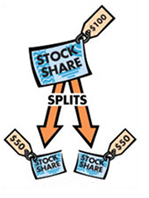
Stock Splits – Boon or Bane?
Let’s begin by defining stock split. A stock split is simply an increase in the number of shares for company. E.g. If an investor holds 100 shares of a specific company which costs INR 10/share and there is a 2:1 stock split, in that case the investor will now hold 200 shares worth INR 5/share.
Liquidity
Stock splits knowledge for stock broker
As a stock market investor, you might be wondering as to why a company would go for a stock split when the amount of money doesn’t change. The answer is very simple! It is about creating more demand and attracting more retail investors by making the pricing more affordable. Sometimes, through a growth trajectory, stock prices can soar high and reach a level, when illiquidity tends to creep in as only worthy investors can find them affordable. That’s when a company thinks of fractioning the cost per share. The downside of stock split is increased liquidity, which means – there can be enlarged price movements leading to larger gains or losses.
Benefits
With regards to opinion, many investors feel that stock splits are good and are accepted positively. However, it might go wrong under a few scenarios. A stock split not only splits the face value per share but also the dividend, earning and asset. There are a few companies who are popular for their non splitting clauses.
There are several ratios of splits such as 1:3 or 2:3, however, 1:2 seems more popular across. Also to be noted that the holding value and company worth remains unchanged post stock split. This can make you wonder that in case there is no change in the holding value, then why the company is splitting its stock. Below will answer in details:
1) Some companies get worried when the stock prices are on a high and it can reduce the affordability for some stockholders, especially the retail investors. Also, splitting up the stock brings the segmental price down to equitable range.
2) When a stock price goes up, it starts diminishing the liquidity. Increasing the number of shares at a lower price helps increase that.
Prudence
As a stock market investor, one should keep a watch on a type of split, which might be a possible risk. There is a facility wherein a company can opt for something called a reverse stock split. This is carried out when the face value per stock is lesser than the minimum value listed on a securities exchange. In such a scenario, the company minimizes the number of exceptional shares and the face value per stock goes up accordingly. This is clearly a signal that there is something wrong with the company in case it can’t keep up the price above the listed price.
which might be a possible risk. There is a facility wherein a company can opt for something called a reverse stock split. This is carried out when the face value per stock is lesser than the minimum value listed on a securities exchange. In such a scenario, the company minimizes the number of exceptional shares and the face value per stock goes up accordingly. This is clearly a signal that there is something wrong with the company in case it can’t keep up the price above the listed price.
Ultimately, an investor should purchase a stock based on its fundamentals and not by speculating whether it would ever split. Stock splitting is not a parameter to be used for making any investment decisions.
Pay Lowest Brokerage Now Start Trading With Us
[email-subscribers namefield=”NO” desc=”Subscribe now to get latest updates!” group=”Public”]













[…] división de acciones Es un evento cuando una empresa aumenta el número de sus acciones emitidas. En una división de […]
[…] stock split is an event when a company increases the number of its shares issued. In a stock split, even as the […]
[…] stock split is an event when a company increases the number of its shares issued. In a stock split, even as the […]